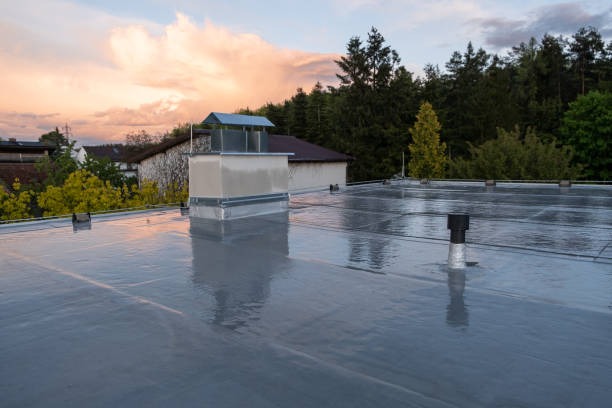Want to safeguard your business investment? Start with the roof over your head — and consider rubber membrane systems.
Rubber membrane systems are a popular choice for commercial roofing. Their durability and cost-effectiveness make them a wise material improvement with long-lasting benefits. But how do they work exactly? Here’s what to know.
Rubber Membrane Roofing Systems Explained
Rubber membranes are a unique kind of roofing system with some clever characteristics. The fundamentals aren’t hard to grasp: It consists of a single- or two-ply membrane made of some kind of rubber, such as EPDM rubber, TPO, or PVC. This membrane is installed over the roof deck to provide lasting protection.
Where things really get interesting is how rubber membrane roofing operates: Rubberized membranes can expand over time, naturally working to seal leaks and maintain a watertight barrier.
Membrane roofing systems are highly resistant to extreme weather conditions — these roofs are built to last for many years. The relative ease of installation and maintenance also lowers the bar to entry, making it an ideal choice for commercial roofing.
Types of Rubber Membrane Systems
There are a few different kinds of rubber membrane roofing systems:
- EPDM (ethylene propylene diene monomer): These synthetic rubber membranes are highly resistant to UV rays, ozone, and extreme temperatures.
- TPO (thermoplastic polyolefin): This material is used to create a membrane that’s highly reflective and energy efficient.
- Modified bitumen: These rubber membranes are impregnated with bitumen — a petroleum byproduct also found in other roofing systems.
- PVC (polyvinyl chloride): This membrane material is known for being highly resistant to chemicals, fire, and extreme temperatures.
Each material has its strengths and weaknesses, and there’s no universal match for every commercial building. It’s best to chat with an expert before getting started: Thorough site assessments are critical to finding the right fit for your property.
Rubber Membrane System Installation
Installing a rubber membrane system requires careful preparation, application, and finishing. The first step is to prepare the roof deck by cleaning and repairing any existing damage. In some severe cases, a structural assessment may also prove helpful.
After the initial prep work, it’s time to apply the membrane to the roof deck. To fix EPDM, TPO, or PVC in place, your installers will use adhesives or mechanical fasteners. With bitumen, the bitumen acts as the bonding agent.
Finally, your installer will seal the membrane. Most professionals use blowtorches to seal bitumen roofs and special weatherproof tapes or sealants to ensure a watertight finish on EPDM, TPO, and PVC.
Maintaining Rubber Membrane Roofing Systems and Getting Started
Want to keep your rubber membrane system in top condition? Get on a regular upkeep schedule.
Routine maintenance is vital to any commercial roofing investment. A good strategy is regularly inspecting for signs of damage, cleaning any dirt or debris, and conducting periodic repairs.
Remember: You might not notice commercial roofing problems until they compromise your business below — so be proactive!
Rubber membrane roofing systems are highly effective and weather-resistant, but no commercial asset lasts without upkeep. Talk to a roofing expert about replacing, repairing, or inspecting your roof soon.

